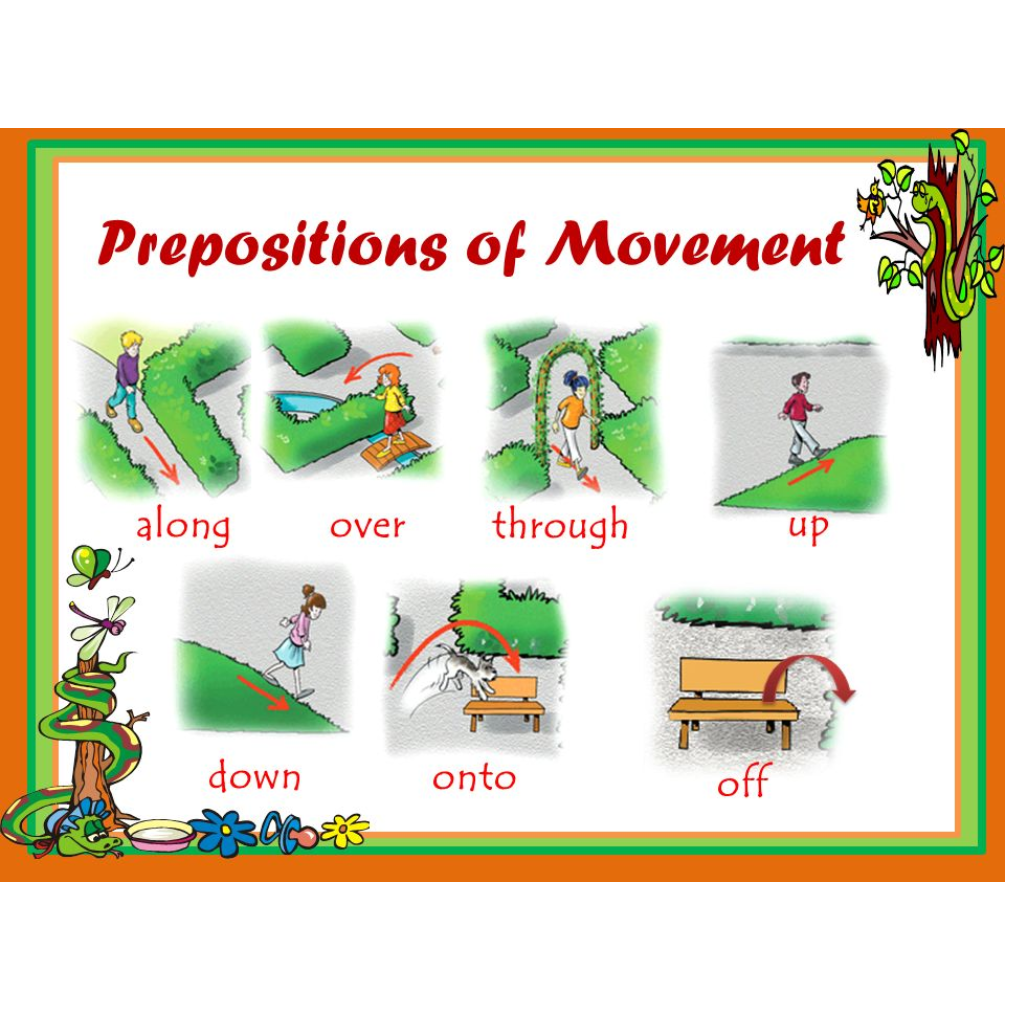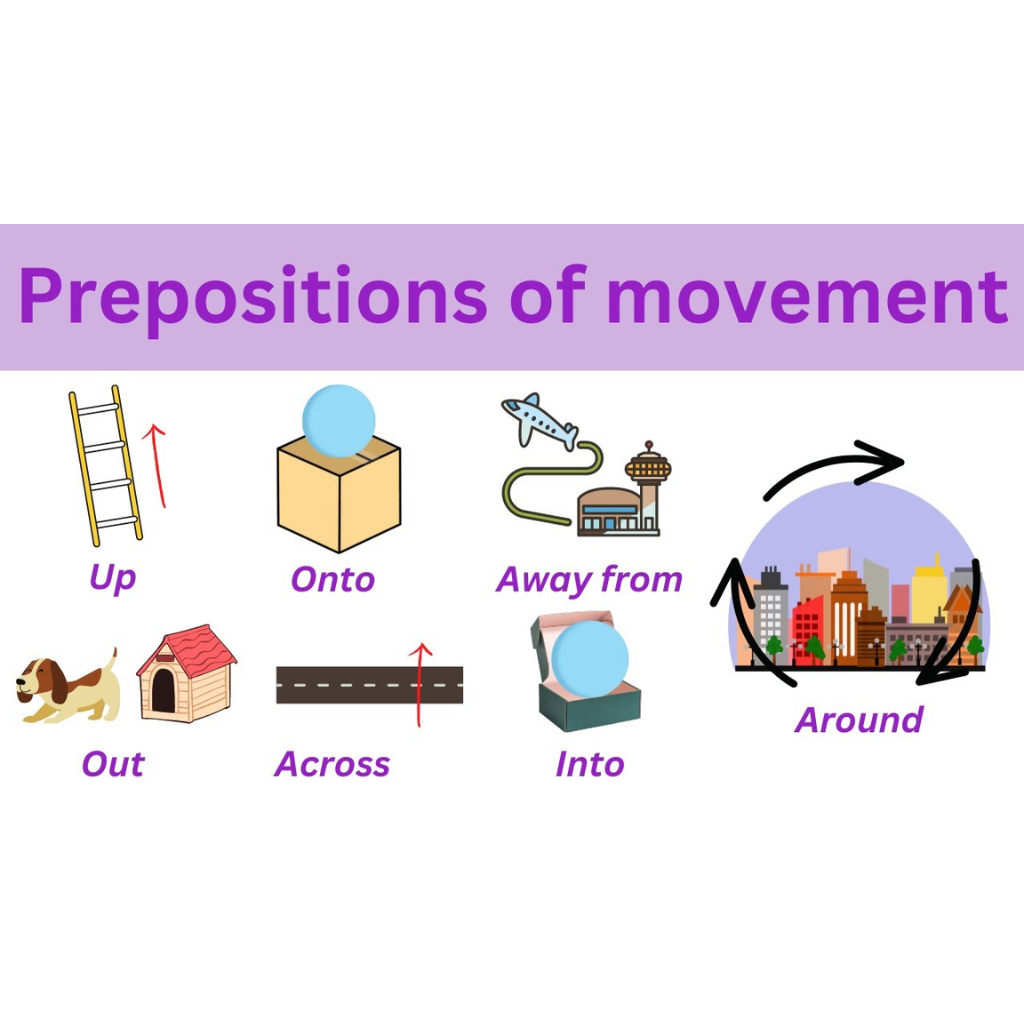Preposition of movements are words that define the movement of a person or object from one place to another. These words are important in our daily conversation as they state the movement of an object from one place to another making easy for detailed explanation. These helpful words include ” to”, “from” and “across”. Learning preposition of movement will make our sentence clearer and easy to explain. Our sentence related to direction will be incomplete without these preposition. So, let’s look at the list of these preposition and their correct use in sentences…..

What Are Prepositions of Movement?
The type of preposition that describe the movement of an object or person, are known as preposition of movement. They answer these type of question like, ” where is something moving” or ” in which direction”. They provide a clear meaning of where something is moving or from where.
Common Preposition of Movement Examples
Here are some common preposition and their use:
| Preposition | Use | Example sentence |
| TO | Moving towards a specific destination | She moved from Korea to USA. |
| Into | Entering an enclosed space | They went into the haunted house. |
| onto | Moving onto a surface | The monkey climbed onto the tree. |
| Over | Moving above something without touching | The Eagle flew over him. |
| Through | Moving from one side to another | Mom drove through the restricted area. |
| Across | Moving from one side to another | He swam across the sea to win the reward. |
| Up | Moving from a lower to a higher place | His house is high up in the mountain. |
| Down | Moving from a higher to a lower place | The new restaurant is down hill. |
| Along | Moving in a line, typically following | The queue was moving along the river. |
| Past | Moving beyond or beside something | She said a real ghost past through her side. |
Basic Preposition of Movement
1. To – Movement Towards a Place
This preposition shows movement of a person or object from one place to another. It indicates that someone or something is moving towards a specific destination.
Example Sentences:
- He is going to the party.
- We are heading to the hotel.
2. Into – Entering a Space
“Into” is used when someone or something enters a defined or enclosed space. It implies a change from being outside to being inside.
Example Sentences:
- The bird flew into the classroom.
- She threw the paper into her bag.
3. Onto – Moving onto a Surface
“Onto” describes movement to a surface. It indicates that someone or something is moving from one place onto a surface, usually from below.
Example Sentences:
- He placed the books onto the table.
- The dog jumped onto the bed.
Advanced Preposition of Movement
1. Through – Moving from One Side to Another
“Through” is used when something moves within a space or object from one side to another, like going inside and coming out the other side.
Example Sentences:
- The car drove through the tunnel.
- We walked through the forest.
2. Over – Moving Above Without Touching
“Over” is used when something moves from one side to another while staying above it, without making contact.
Example Sentences:
- The bird flew over the lake.
- He jumped over the fence.
3. Around – Moving in a Circular Direction
“Around” describes circular motion or movement surrounding something. It shows the idea of moving along the outer edge.
Example Sentences:
- They walked around the building.
- The moon moves around the Earth.
Differences Between Prepositions of Movement
Many people get confuse because two prepositions, so here is a table showing difference between them:
| Preposition | Key Difference | Example Sentences |
| To vs. Into | To indicate a direction, Into suggests entry | She went to the party./ He got into the car. |
| Over vs. Above | Over suggests movement, Above is a static position | The Wind blew over me./ The book is above the shelf. |
| Along vs. Across | Along follows a line, Across means going from one side to another | They were walking across the river./ He swam across the whole Atlantic Ocean. |
Prepositions of Movement in Real-Life Situations
Movement in Travel
Prepositions of movement are very useful when talking about travel, directions, and motion.
Example Sentences:
- We drove through the city on our way to the countryside.
- The train goes past several villages before reaching its final stop.
Movement in Sports
In sports, we often describe actions using prepositions of movement to indicate the direction and flow of the game.
Example Sentences:
He ran around the track twice.
The ball went over the goalpost.
Example Sentences of Preposition of Movement
| Preposition of Movement | Example Sentence |
| Across | Walking across the river is dangerous. |
| Along | His house is along side the hill. |
| Around | The car drove around the park for an hour |
| Into | She putted her make-up into the box. |
| Out of | The food was cooked out of the world. |
| Onto | Something fell onto the clothes. |
| Off | The glass fell off the table. |
| Over | The sweet breeze flew over him. |
| Past | They were walking past the lane. |
| Through | He came through the forest to reach here. |
| Toward | I was moving angrily toward my friend. |
| Up | Up there in the sky, sun was shinning brightly. |
| Down | There was one house down hill. |
| Across from | The hospital is across from the school. |
| Away from | That is too faraway from my home. |
| Under | There was something under the table. |
| Between | The jungle is between two rivers. |
| Alongside | WE will walk past alongside the river. |
| Onto | It fell onto the couch. |
| Over | Put some butter over the toast. |
List of Preposition of Movement
- Across
- Along
- Around
- Into
- Out of
- Onto
- Off
- Over
- Past
- Through
- Toward
- Up
- Down
- Across from
- Away from
- Under
- Between
- Alongside
- To
- From
- Over
- Underneath
- Behind
- In front of
- Beyond
- Through
- Out
- Near
- Beside
- Around
FAQs:
- What is an example of a preposition of movement?
An example of a preposition of movement is “through.”
For example:
- She walked through the park.
- What are the prepositional verbs of movement?
Prepositional verbs of movement are verbs that are commonly followed by a preposition indicating direction or movement. Some common examples include:
- Run into – He ran into the room.
- Jump over – She jumped over the fence.
- Climb up – They climbed up the ladder.
- Go through – We went through the tunnel.
- Walk across – He walked across the street.
- Get off – She got off the bus.
- How do you teach prepositions of movement?
Teaching prepositions of movement can be engaging and interactive. Here are some effective methods:
1. Use Visuals & Real-Life Examples
- Show pictures or videos of people moving (e.g., walking through a door, jumping over a hurdle).
- Use arrows and diagrams to demonstrate movement (e.g., a ball rolling down a hill).
2. TPR (Total Physical Response) Activities
- Have students physically act out prepositions (e.g., “Walk across the room,” “Jump over a chair”).
- Set up obstacle courses where students must go under, over, through, etc.
3. Games & Activities
- Simon Says: Give movement-based commands (e.g., “Step onto the chair!”).
- Treasure Hunt: Hide objects and give movement-based clues (e.g., “Go through the door, then look under the table”).
- Matching Game: Have students match pictures with correct prepositions.
4. Storytelling & Role-Playing
- Create a story where characters move in different ways (e.g., “The cat jumped onto the table and ran through the door”).
- Let students act out stories using movement-based prepositions.
5. Worksheets & Interactive Exercises
- Fill-in-the-blank exercises (e.g., “The ball rolled __ the hill”).
- Sentence matching (match actions with prepositions).
6. Videos & Songs
- Use educational songs or animated videos that demonstrate movement prepositions.
- Have students sing along and do corresponding actions.
Conclusions:
Prepositions of movement describe the direction of an action from one place to another. Common examples include into, onto, through, across, past, up, down, over, under, toward, and out of. They are used with action verbs like walk, run, jump, climb, and go to indicate motion. These prepositions help make sentences clearer and more dynamic.
Example: She ran through the park.

